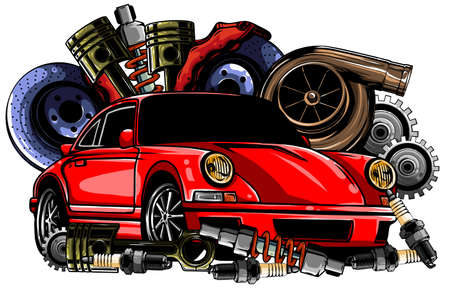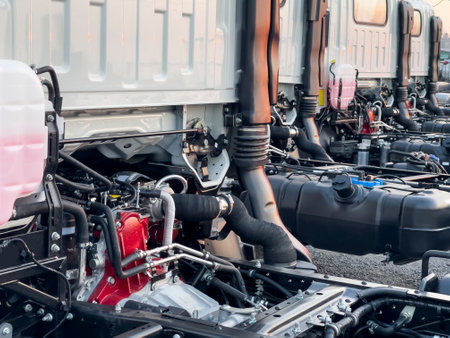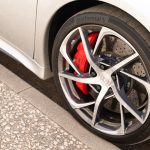1. Introduction to Dyno Tuning and Road Tuning
When it comes to optimizing engine performance, tuning plays a crucial role. There are two primary methods used in the automotive world: dyno tuning and road tuning. Both methods have their own advantages, and the choice between them depends on the vehicle, modifications, and driving needs. Let’s break down what dyno tuning and road tuning are and how they contribute to enhancing your cars performance.
What Is Dyno Tuning?
Dyno tuning, short for dynamometer tuning, involves testing and tuning a vehicle in a controlled environment using a dynamometer. A dyno is a specialized machine that measures horsepower, torque, air-fuel ratio, and other engine parameters in real-time while simulating different driving conditions.
How Dyno Tuning Works
- The car is strapped onto a dynamometer, with the wheels placed on rollers.
- Engine performance is tested under simulated driving conditions.
- A tuner adjusts parameters such as air-fuel ratio, ignition timing, and boost levels to optimize performance.
- Repeated runs are performed to fine-tune the ECU (Engine Control Unit) for maximum efficiency and power.
What Is Road Tuning?
Road tuning, also known as street tuning, involves making adjustments while driving the vehicle on actual roads. This method provides real-world data since tuning adjustments are made under normal or aggressive driving conditions.
How Road Tuning Works
- The tuner installs logging software to collect data while driving.
- The vehicle is tested across different speeds, throttle positions, and road conditions.
- Adjustments are made based on live data collected during real-world driving.
- Multiple pulls and adjustments are performed to fine-tune the engine.
Key Differences Between Dyno Tuning and Road Tuning
| Aspect | Dyno Tuning | Road Tuning |
|---|---|---|
| Testing Environment | Controlled (on a dyno machine) | Real-world roads and conditions |
| Data Accuracy | Highly precise, detailed metrics | Real-world driving data |
| Safety | Safe, no external interference | Risk of traffic and road hazards |
| Cost | Generally higher due to dyno rental | Usually lower, depending on tuner |
| Use Case | Best for high-performance builds | Ideal for street-driven vehicles |
Both dyno tuning and road tuning are essential in different scenarios. While dyno tuning provides a controlled environment with precise data, road tuning allows tuners to make adjustments based on real driving conditions. Understanding these differences is key to selecting the right tuning method for your vehicle.
2. What is Dyno Tuning?
Dyno tuning, short for dynamometer tuning, is a process where a vehicle is tested and adjusted using a specialized machine called a dyno. The dyno allows tuners to simulate real-world driving conditions in a controlled environment, helping them optimize a cars performance safely and accurately.
How Does Dyno Tuning Work?
During a dyno tuning session, the vehicle is placed on a dynamometer, which measures key performance metrics such as horsepower, torque, air-fuel ratio, and engine load. The tuner then adjusts the engine’s parameters, including fuel delivery, ignition timing, and boost levels (for turbocharged or supercharged vehicles), to maximize performance and efficiency.
Benefits of Dyno Tuning
Dyno tuning provides several advantages, especially for those seeking precise tuning and performance optimization. Here are some key benefits:
| Benefit | Description |
|---|---|
| Controlled Environment | Dyno tuning eliminates external variables such as road conditions and weather, ensuring consistent results. |
| Accurate Data | The dyno provides real-time data on power output, air-fuel ratios, and other essential parameters. |
| Safe Testing | Since the vehicle stays in a stationary position, tuners can push the engine safely without risks associated with road testing. |
| Optimized Performance | Adjustments made with precise measurements help enhance power, fuel efficiency, and drivability. |
When Should You Choose Dyno Tuning?
Dyno tuning is ideal for car enthusiasts upgrading their engine setups, performance vehicles requiring fine-tuned adjustments, and drivers looking to extract the most power while maintaining reliability. If you want highly accurate tuning results without worrying about road hazards or inconsistent conditions, dyno tuning is the way to go.
Is Dyno Tuning Right for Your Car?
While dyno tuning offers precision and safety, it can be costly and may not always replicate real-world driving scenarios. In the next section, we’ll explore an alternative approach: road tuning.

3. What is Road Tuning?
Road tuning is the process of fine-tuning a vehicle’s engine and performance while driving on actual roads, rather than on a stationary dyno. This method helps optimize a car’s real-world drivability by adjusting fuel maps, ignition timing, boost levels, and other parameters in real driving conditions.
How Road Tuning Differs from Dyno Tuning
Unlike dyno tuning, which takes place in a controlled environment, road tuning involves adjusting the car while it experiences actual load, road conditions, and airflow dynamics. This allows tuners to get real-time feedback on how the car behaves under everyday driving conditions. Heres a comparison between the two:
| Aspect | Road Tuning | Dyno Tuning |
|---|---|---|
| Testing Environment | Real-world roads | Controlled indoor dyno |
| Load Simulation | Actual driving conditions | Simulated but controlled |
| Adjustments | Based on live performance data | Based on simulated conditions |
| Safety | Risks due to traffic and road conditions | Safer and more controlled |
| Cost | Generally lower (no dyno rental needed) | Dyno rental adds to the cost |
Real-World Application of Road Tuning
Road tuning is especially beneficial for street-driven cars, as it allows fine-tuning for real driving situations like stop-and-go traffic, highway cruising, and acceleration under various conditions. Its also useful for vehicles that experience varying loads, such as trucks carrying cargo or performance cars that will be used for spirited driving on the street rather than just for track or dyno numbers.
Key Benefits of Road Tuning
- Real-World Accuracy: Ensures that fuel, timing, and boost adjustments work optimally in normal driving conditions.
- Cost-Effective: Eliminates the need for expensive dyno rental sessions.
- Better Driveability: Helps smooth out throttle response, part-throttle tuning, and conditions like uphill driving.
Potential Challenges
While road tuning has many advantages, it also presents some challenges. It requires a safe stretch of road for testing, and factors like changing weather and traffic can make consistent tuning harder. Additionally, its crucial to follow local laws and safety regulations to ensure that the tuning process doesnt pose risks to others on the road.
4. Pros and Cons of Dyno Tuning vs. Road Tuning
When deciding between dyno tuning and road tuning, its essential to consider the advantages and disadvantages of each approach. Factors like accuracy, cost, and real-world applicability play a crucial role in determining which method is best for your vehicle and performance goals.
Accuracy
One of the main differences between dyno tuning and road tuning is how accurately the data can be measured and adjusted.
| Factor | Dyno Tuning | Road Tuning |
|---|---|---|
| Data Consistency | Highly controlled environment, gives precise and repeatable data. | Real-world conditions, but inconsistent due to variables like traffic and weather. |
| Measurement Accuracy | Uses advanced sensors to measure horsepower, torque, and air-fuel ratio with high precision. | Relies on real-world driving conditions, but can be less precise due to external factors. |
Cost
Cost is another crucial factor when choosing a tuning method. Dyno tuning usually costs more, but it may provide better long-term value.
| Factor | Dyno Tuning | Road Tuning |
|---|---|---|
| Upfront Cost | Can be expensive due to the use of specialized dyno equipment and time-intensive tuning. | Generally more affordable since no dyno is required. |
| Long-Term Value | More precise tuning can lead to better performance and fuel efficiency in the long run. | May require additional fine-tuning over time if conditions change. |
Real-World Applicability
How a car performs in real-world conditions is an important consideration when tuning for drivability and reliability.
| Factor | Dyno Tuning | Road Tuning |
|---|---|---|
| Replicating Real-World Driving | Simulates certain conditions but may not fully replicate actual street or track driving. | Takes environmental factors like elevation, road surface, and air density into account. |
| Drivability & Performance | Great for extracting peak power but may not always translate perfectly to real-world driving. | Reflects how the car performs in real situations, improving throttle response and reliability. |
Safety & Risk
Safety is another important factor. Both methods have their risks, though they differ in nature.
| Factor | Dyno Tuning | Road Tuning |
|---|---|---|
| Risk of Engine Damage | Constant high-load testing may cause excessive heat and stress on components. | Less wear on the engine during regular driving, but improper tuning can lead to reliability issues. |
| Safety for the Driver | Safer since the car remains stationary and is tested in a controlled environment. | Risk involved in high-speed pulls on public roads, which can be dangerous and illegal. |
Choosing the Right Method
Both tuning methods have pros and cons, and the right choice depends on your goals. If you want maximum accuracy and a controlled environment, dyno tuning is the better option. However, if you prioritize real-world drivability and cost, road tuning may be the way to go. Many tuners use a combination of both methods to achieve the best results.
5. Which Tuning Method is Right for You?
Choosing between dyno tuning and road tuning depends on your driving needs, budget, and performance goals. Each method has its advantages, and the right choice comes down to what you want to achieve with your vehicle.
Consider Your Driving Needs
Are you tuning for daily driving, track use, or drag racing? Different tuning methods offer benefits based on how you use your vehicle.
| Driving Style | Recommended Tuning | Why? |
|---|---|---|
| Daily Driving | Road Tuning | Better real-world drivability and fuel efficiency tuning. |
| Track Racing | Dyno Tuning | More precise tuning for peak performance in controlled conditions. |
| Drag Racing | Dyno Tuning | Fine-tunes power output and launch control for maximum performance. |
| Off-Road Driving | Road Tuning | Allows tuning based on actual terrain and load conditions. |
Budget Considerations
Dyno tuning typically costs more due to equipment usage and detailed tuning sessions. Road tuning may be more affordable, but it requires an experienced tuner to ensure accuracy.
| Tuning Method | Estimated Cost | Cost Factors |
|---|---|---|
| Dyno Tuning | $400 – $1,000 | Dyno session fees, labor costs, time spent fine-tuning. |
| Road Tuning | $200 – $600 | Tuner fees, data logging requirements, tuning duration. |
Performance Goals
Your goals will determine which tuning method makes the most sense. If youre after absolute power and precision, dyno tuning is the way to go. If youre more concerned with real-world driving improvements, road tuning may be a better fit.
When to Choose Dyno Tuning:
- If youre building a high-performance race car.
- You want absolute control over horsepower gains.
- Youre dialing in specific power curves for precise tuning.
When to Choose Road Tuning:
- If you need a more cost-effective tuning solution.
- You want real-world conditions to influence your tune.
- You prioritize drivability, not just peak performance.
Final Thoughts on Choosing the Right Method
Your ideal tuning method depends on what you expect from your vehicle. If youre looking for the best possible accuracy and power, dyno tuning is the way to go. However, if real-world drivability and adaptability are more important, road tuning may be the better option. Consider your needs, budget, and performance goals before making a decision.


